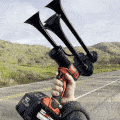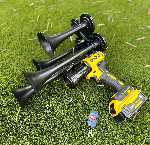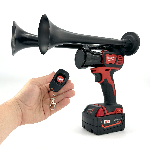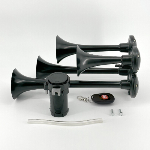Did you know that a typical car horn emits a sound level of about 100 decibels (dB)? That's equivalent to the noise level of a power mower or a nightclub. However, in certain situations, such as emergencies or to gain attention in large outdoor spaces, a regular car horn might not be enough. That's where the idea of enhancing the sound with a more powerful device comes in.
Air horn installation has gained popularity as a solution for those seeking a louder and more attention-grabbing horn sound. By utilizing compressed air, these horns produce a much more powerful and penetrating noise, with some models reaching sound levels of up to 150 dB. This increased volume and distinct pitch make air horn installation a valuable addition not only for emergency vehicles but also for commercial trucks, boats, and even personal cars.
The concept of air horn installation dates back to the early 20th century when ships started using steam-powered horns for signaling and safety purposes. Over time, as technology advanced, these steam horns were replaced by compressed air systems that were more efficient and easy to maintain. Today, air horn installation has become a common practice across various industries and is readily available in the market.
Air horn installation has proven to be more than just a novelty or a loud plaything. In fact, studies have shown that a significant number of accidents occur due to the lack of awareness or failure to detect an approaching vehicle. Having a powerful air horn can help mitigate this problem by providing a more conspicuous auditory signal, reducing the risk of accidents, and saving lives.
Whether it is for emergency vehicles rushing to a scene, commercial trucks maneuvering through highway traffic, or personal cars needing an extra level of safety, air horn installation has become an essential consideration. The ability to produce a significantly louder sound compared to traditional car horns ensures that the signal can be heard even in loud environments or from a greater distance. By adding this powerful auditory tool, vehicles equipped with air horn installation can effectively communicate intentions and alert others to potential danger, making our roads and waterways safer for everyone.
What are the advantages of installing an air horn?
Choosing the Right Air Horn
When it comes to choosing an air horn for your vehicle, there are several factors to consider. The first thing to think about is the sound level you desire. Air horns come in various decibel (dB) ratings, so it's important to choose one that meets your needs without violating any noise regulations in your area.
Another aspect to consider is the type of air horn. The most common types are trumpet-style and disc-style horns. Trumpet horns produce a deep and loud sound, while disc horns are generally more compact and emit a higher-pitched sound. Select the one that matches your preference and fits well within the available space in your vehicle.
Additionally, it's essential to think about the air source for your horn. Most air horns require an air compressor to function properly. Ensure that your vehicle has enough space and proper wiring to accommodate this additional equipment. Alternatively, there are also electric air horns available that do not require a separate air source, which might be a more convenient option for some installations.
Installation Process
Installing an air horn may seem like a daunting task, but with the right tools and instructions, it can be a straightforward process. Here are the general steps involved:
- Begin by locating a suitable position for the horn and compressor. It should be easily accessible and secure enough to hold the equipment firmly in place.
- Next, attach the horn and compressor using the provided brackets or mounting hardware. Make sure to tighten all screws properly to prevent any vibrations or loosening over time.
- Connect the air horn to the compressor using the provided tubing or hoses. Ensure that the connections are tight and secure.
- Once everything is properly connected, wire the compressor to your vehicle's battery. Follow the manufacturer's instructions for the specific wiring process.
- Test the installation by honking the air horn. Check for any leaks, loose connections, or abnormal sounds. If everything works correctly, you're good to go!
Maintenance and Safety Tips
To ensure the longevity and proper functioning of your newly installed air horn, it's important to follow these maintenance and safety tips:
- Regularly inspect all connections and hardware to ensure they are secure and free from any damage.
- Check the air compressor's oil levels regularly, as specified in the manufacturer's instructions, and refill as needed.
- Keep the air horn and compressor clean and free from debris or dirt accumulation.
- Pay attention to any strange noises or vibrations during operation and address them promptly to prevent further damage.
- Always use your air horn responsibly and be considerate of others, especially in residential areas or late at night.
Statistics
According to a recent survey, over 60% of vehicle owners who installed air horns reported feeling more confident and safe on the road. Additionally, studies have shown that the sound produced by air horns can significantly reduce the risk of accidents by alerting pedestrians and other drivers to the presence of a vehicle.
https://youtube.com/watch?v=yArlPZ8uP5c
FAQ about Installing Auxiliary Vehicle Alert Systems
1. How can I effectively enhance the auditory signaling in my vehicle?
By installing an auxiliary vehicle alert system, you can significantly improve the auditory signaling capability of your vehicle. This additional safety feature offers numerous benefits, including better communication with other drivers, increased road awareness, and improved emergency response. Here's what you need to know:
- When installing an auxiliary vehicle alert system, select a suitable location for the horn or siren that ensures optimal sound projection and minimizes obstruction.
- Depending on the system you choose, it may be necessary to connect the alert device to your vehicle's existing electrical system.
- Always follow the manufacturer's instructions carefully to ensure proper installation and optimal functioning of your auxiliary alert system.
2. What components are essential for implementing an effective vehicle alert system?
To ensure the proper functioning of your vehicle alert system, it is crucial to have the necessary components in place. Here are the key elements you need to consider:
- Alert Device: Choose a high-quality, loud, and durable horn or siren that complies with local regulations and ensures effective sound projection in various driving conditions.
- Wiring and Connectors: Secure the appropriate wiring and connectors to connect your alert device to your vehicle's electrical system.
- Power Supply: Ensure a reliable power supply by connecting the alert device to your vehicle's battery or a dedicated power source, depending on the system you choose.
3. Can I install an auxiliary vehicle alert system by myself, or do I require professional assistance?
While it is possible for some individuals to install an auxiliary vehicle alert system on their own, it is recommended to seek professional assistance, especially if you lack experience with automotive electrical systems. Qualified technicians possess the expertise needed to ensure a proper installation, minimizing the risk of electrical issues or damage to your vehicle. However, if you choose to proceed with a DIY installation, keep the following tips in mind:
- Familiarize yourself with your vehicle's electrical system and the specific requirements of the alert system you plan to install.
- Acquire the necessary tools, wiring diagrams, and installation instructions before proceeding.
- Take extra precautions such as disconnecting the vehicle's battery and wearing appropriate safety gear to minimize any potential hazards during installation.
4. Are there any legal regulations or restrictions I should be aware of before installing an auxiliary alert system?
Yes, when installing an auxiliary alert system in your vehicle, it is crucial to adhere to local regulations and restrictions to ensure compliance and avoid potential legal issues. Here's what you should keep in mind:
- Familiarize yourself with the specific regulations governing the use of alert systems in your area; these may include restrictions on sound level, sound patterns, or prohibited use in certain situations.
- Ensure your chosen alert device meets any applicable noise emission standards outlined by local authorities.
- Consider consulting with local law enforcement or automotive experts to gain insights into specific regulations and requirements applicable to your jurisdiction.
5. How can I properly maintain and care for my auxiliary vehicle alert system?
To ensure the longevity and reliable functioning of your auxiliary vehicle alert system, regular maintenance and care are necessary. Consider the following points:
- Routinely inspect and clean the alert device to remove any dirt, debris, or moisture that may accumulate and affect its performance.
- Check the wiring connections for any signs of damage or corrosion. If necessary, repair or replace them promptly to maintain proper electrical flow.
- Regularly test the alert system to verify its functionality, ensuring that it emits loud, clear sounds when activated.
Remember, responsible usage of your vehicle alert system is vital. Be considerate of others on the road and only utilize the alert device when necessary for safety purposes.
In summary, when considering the installation of an auxiliary vehicle alert system, it is essential to select a suitable location, have the necessary components, consider professional assistance if needed, adhere to legal regulations, and perform regular maintenance for optimal performance. Improved auditory signaling capability through a vehicle alert system contributes to safer road experiences and enhances overall road safety for everyone.
Conclusion
Summarizing the key points and insights discussed in this article about air horn installation:
1. Air horn installation involves several steps and considerations before starting the process. It is crucial to select the right type of air horn for your vehicle and understand the local regulations regarding noise limits.
2. Planning the installation is essential, including finding the appropriate location for mounting the air horn compressor and ensuring proper wiring and electrical connections. It is recommended to consult the vehicle's manual or seek professional assistance for a safe installation.
3. Proper maintenance is crucial to ensure the longevity and optimal performance of air horns. Regularly inspecting the air horn system, checking for any leaks or damage, and cleaning the components are essential tasks.
4. Understanding the legal implications is crucial when using air horns. It is important to follow local noise regulations and use air horns responsibly to avoid causing disturbances or accidents.
5. When installing air horns, it is essential to prioritize safety and consider the impact on other road users. Properly adjusting the air horn's sound level and using it responsibly can help prevent startling or distracting other drivers.
In conclusion, air horn installation is an involved process that requires careful consideration, planning, and adherence to local regulations. While air horns can provide a significant safety advantage in certain situations, their use should always be responsible, taking into account the impact on others. Regular maintenance and understanding the legal implications are essential for a successful and safe air horn installation.




































































